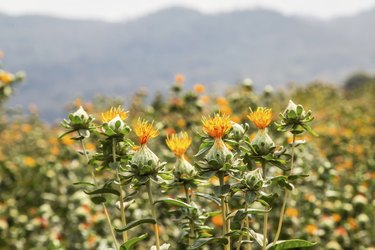
Safflowers (Carthamus tinctorius) and sunflowers (Helianthus spp.) share similarities, such as the golden-yellow to orange petals, upright stalks and rough green leaves. They both bring a sunny element to the garden and attract birds when the flowers go to seed. Where these two flowers show their differences is in the shape of the flower itself. The sunflower has an open disk-shaped flower while safflowers have a tight green ball-shaped base topped with a tuft of colorful petals. Safflowers and sunflowers both belong to the Asteraceae, or sunflower, family.
Sunflowers in Bloom
Video of the Day
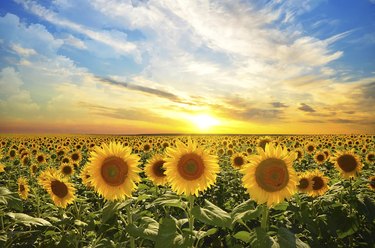
When a sunflower blooms, the large, round flower head opens, revealing a rough central disk surrounded by gold, yellow or orange ray-shaped petals. Each flower head has dozens or hundreds of tiny true flowers. Look closely at the center of a sunflower and you'll see tiny flowers packed together. This is also where the bees and other pollinators spend their time. The ray petals that surround the central disk are showy, attracting pollinators. A standard sunflower bloom is generally 6 inches in diameter. If you want something even more dramatic, look for a giant cultivar such as the "Mammoth Russian" with its 15-inch diameter flower head. If small is more your thing, look for the cultivars "Elf" or "Junior" with their 4- to 5-inch-diameter flowers.
Video of the Day
Safflowers in Bloom

In contrast to the open circular shape of a sunflower, the safflower bloom consists of a bulbous base topped with bright yellow or orange petals that create a tuft. A safflower bloom has a similar shape to a milk thistle (Silybum marianum), hardy in USDA zones 7 through 11. Safflower petals are edible adding color and flavor to food dishes. You can even use the petals in place of true saffron (Crocus sativus), hardy in USDA zones 5 through 8.
Sunflower Differences
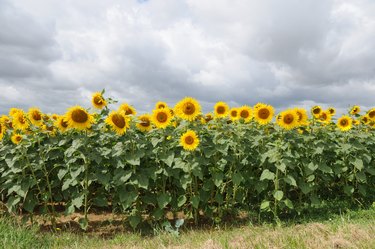
Sunflowers include both annuals (Helianthus annuus) and perennials (Helianthus spp.), with 38 perennial species native to North America, according to Texas A&M AgriLife Extension. Depending on the type, perennial sunflowers are hardy in U.S. Department of Agriculture plant hardiness zones 3 through 11. You can distinguish between the two types by examining the root structure. Perennial types have thick tuberous roots, whereas annual types have roots that are more stringy. Perennials include Beach Sunflower (Helianthus debilis), hardy in USDA zones 8 through 11 and working well as a salt-tolerant ground cover and Swamp Sunflower (Helianthus angustifolius), hardy in USDA zones 6 through 9, with 2 to 3 inch flowers that cover 7 feet tall plants.
Growth Habit Differences
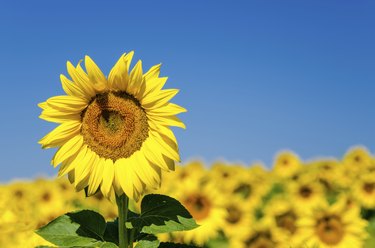
Safflowers, which perform as annuals and sunflowers share an erect growth habit, coarse dark-green leaves and thick, hairy stalks topped with large flowers. Safflowers grow 3 tall and 1 to 1 1/2 feet wide. Common sunflowers grow anywhere from 3 to 10 feet tall and up to 3 feet wide. You can even find sunflowers growing 15 to 16 feet tall. If you want one of these giants look for cultivars such as "Sunzilla" and "Kong Hybrid".
Growing Similarities
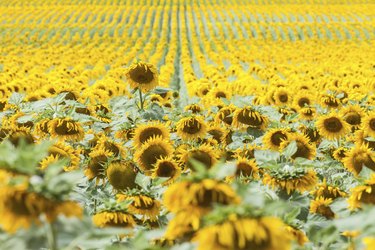
You can grow safflowers and sunflowers side by side in a garden as both thrive in the same growing conditions. Pick a spot that gets full sun where the soil is loamy or sandy with good drainage. Avoid wet areas that drain poorly or you could end up with root rot. Both safflowers and sunflowers work well visually in informal areas such as cutting gardens and cottage gardens. They also add a splash of color while attracting valuable pollinators in the vegetable garden.
Cut Flowers and Dried

You can add safflowers to fresh cut flower arrangements or dry them for dried arrangements. If you're growing safflowers for cutting, look for one of the thorn-less cultivars such as "Grenade Orange." Sunflowers make striking cut flowers when fresh, but once they start to dry, the petals fall off and make a mess. Cut sunflowers and safflowers as soon as the petals open to get the longest vase life. Sunflowers have a vase life of one week while safflowers last up to 10 days
- Sunset Plant Finder: Carthamus Tinctorius
- Missouri Botanical Garden: Helianthus annuus
- Ball Seed: Grenade Orange Carthamus
- Mother Earth Living: Herb to Know: Safflower
- Organic Gardening: Sunflower Varieties for All Occasions
- Cornell Department of Horticulture: Sunflowers
- Floral Design Institute: Carthamus, Safflower
- University of Florida IFAS Extension: Helianthus Debilis Beach Sunflower
- University of Vermont: Helianthus
- Texas A&M AgriLife Extension: Sunflowers - Enjoy the Flowers…Give Birds a Treat